Chinese astronauts Fei Junlong and Nie Haisheng landed safely in Mongolia on Sunday, after spending 5 days in orbit. Their Shenzhou-6 capsule touched down by parachute less than a kilometre from their target, and were met by helicopters and off-road vehicles. Fei and Nie will spend the next 14 days in isolation, to observe their post flight health; however, their families will be able to visit. The Chinese Space Administration has hinted that spacewalks and women astronauts will be in future missions.
Mid-Latitude Glaciers on Mars
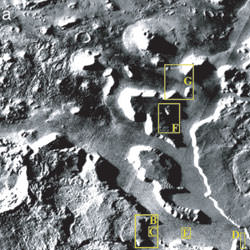
Viking image of Mars. Image credit: NASA/JPL. Click to enlarge.
New high-resolution images of mid-latitude Mars are revealing glacier-formed landscapes far from the Martian poles, says a leading Mars researcher.
Conspicuous trains of debris in valleys, arcs of debris on steep slopes and other features far from the polar ice caps bear striking similarities to glacial landscapes of Earth, says Brown University’s James Head III. When combined with the latest climate models and orbital calculation for Mars, the geological features make a compelling case for Mars having ongoing climate shifts that allow ice to leave the poles and accumulate at lower latitudes.
“The exciting thing is a real convergence of these things,” said Head, who will present the latest Mars climate discoveries on Sunday, 16 October, at the Annual Meeting of the Geological Society of America in Salt Lake City (specific time and location provided below).
“For decades people have been saying that deposits at mid and equatorial latitudes look like they are ice-created,” said Head. But without better images, elevation data and some way of explaining it, ice outside of Mars’ polar regions was a hard sell.
Now high-resolution images from the Mars Odyssey spacecraft’s Thermal Emission Imaging System combined with images from the Mars Global Surveyor spacecraft’s Mars Orbiter Camera and Mars Orbiter Laser Altimeter can be compared directly with glacier features in mountain and polar regions of Earth. The likenesses are hard to ignore.
For instance, consider what Head calls “lineated valley fill.” These are lines of debris on valley floors that run downhill and parallel to the valley walls, as if they mark some sort of past flow. The same sorts of lines of debris are seen in aerial images of Earth glaciers. The difference is that on Mars the water ice sublimes away (goes directly from solid ice to gas, without any liquid phase between) and leaves the debris lines intact. On Earth the lines of debris are usually washed away as a glacier melts.
The lines of debris on Mars continue down valleys and converges with other lines of debris – again, just like what’s seen on Earth where glaciers converge.
“There’s so much topography and the debris is so thick (on Mars) that it’s possible some of the ice might still be there,” said Head. The evidence for present day ice includes unusually degraded recent impact craters in these areas – just what you’d expect to see if a lot of the material ejected from the impact was ice that quickly sublimed away.
Another peculiarly glacier-like feature seen in Martian mid-latitudes are concentric arcs of debris breaking away from steep mountain alcoves – just as they do at the heads of glaciers on Earth.
As for how ice could reach Mars lower latitudes, orbital calculations indicate that Mars may slowly wobble on its spin axis far more than Earth does (the Moon minimizes Earth’s wobble). This means that as Mars’ axis tilted to the extremes – up to 60 degrees from the plane of Mars’ orbit – the Martian poles get a whole lot more sunshine in the summertime than they do now. That extra sun would likely sublime water from the polar ice caps, explains Head.
“When you do that you are mobilizing a lot of ice and redistributing it to the equator,” Head said. “The climate models are saying it’s possible.”
It’s pure chance that we happen to be exploring Mars when its axis is at a lesser, more Earth-like tilt. This has led to the false impression of Mars being a place that’s geologically and climatically dead. In fact, says Head, Mars is turning out to be a place that is constantly changing.
Original Source: Geological Society of America News Release
Spiral Galaxy NGC 2403
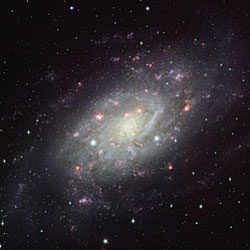
Spiral Galaxy NGC 2403. Image credit: Subaru. Click to enlarge.
Subaru Telescope, using Suprime-Cam, took the clearest most complete image to date of the spiral galaxy NGC 2403. At a distance of 10 million light years, NGC 2403 is an Sc type galaxy, which has open spiral arms and a small nucleus. It is approximately half the mass of our own galaxy, the Milky Way, and has an abundance of neutral hydrogen gas. In the spiral arms we see active star formation regions in red, clusters of young blue stars called OB associations, and darker regions called dust lanes where light is blocked by gas and dust within the galaxy.
This is not the first time NGC 2403 has been studied. Edwin Hubble used NGC 2403 as evidence that more distant galaxies move more quickly away from us, now called Hubble’s Law. It was also used to develop the Tully-Fisher relation, which states that there is a relation between a galaxy’s rotational speed and its brightness. NGC 2403 has become an important standard galaxy when deciding the distances to other galaxies, as we recognize the vast expanse of space.
Larger galaxies are thought to have developed from the collision and merger of smaller galaxies. Mergers can leave enduring marks on a galaxy’s halo, the most extended and generally spherical component of a galaxy. There is evidence that relatively young stars exist in the halo of NGC 2403, hinting at a recent merger with another galaxy. Astronomers are now studying this image to see if the color and brightness of the stars in the halo of NGC 2403 will reveal conclusive evidence of past mergers.
Original Source: Subaru News Release
New Advances for Liquid-Fueled Rockets

An artist’s rendering of the Integrated Powerhead Demonstrator. Image credit: NASA. Click to enlarge.
When you think of future rocket technology, you probably think of ion propulsion, antimatter engines and other exotic concepts.
Not so fast! The final chapter in traditional liquid-fueled rockets has yet to be written. Research is underway into a new generation of liquid-fueled rocket designs that could double performance over today’s designs while also improving reliability.
Liquid-fueled rockets have been around for a long time: The first liquid-powered launch was performed in 1926 by Robert H. Goddard. That simple rocket produced roughly 20 pounds of thrust, enough to carry it about 40 feet into the air. Since then, designs have become sophisticated and powerful. The space shuttle’s three liquid-fueled onboard engines, for instance, can exert more than 1.5 million pounds of combined thrust en route to Earth orbit.
You might assume that, by now, every conceivable refinement in liquid-fueled rocket designs must have been made. You’d be wrong. It turns out there’s room for improvement.
Led by the US Air Force, a group consisting of NASA, the Department of Defense, and several industry partners are working on better engine designs. Their program is called Integrated High Payoff Rocket Propulsion Technologies, and they are looking at many possible improvements. One of the most promising so far is a new scheme for fuel flow:
The basic idea behind a liquid-fueled rocket is rather simple. A fuel and an oxidizer, both in liquid form, are fed into a combustion chamber and ignited. For example, the shuttle uses liquid hydrogen as its fuel and liquid oxygen as the oxidizer. The hot gases produced by the combustion escape rapidly through the cone-shaped nozzle, thus producing thrust.
The details, of course, are much more complicated. For one, both the liquid fuel and the oxidizer must be fed into the chamber very rapidly and under great pressure. The shuttle’s main engines would drain a swimming pool full of fuel in only 25 seconds!
This gushing torrent of fuel is driven by a turbopump. To power the turbopump, a small amount of fuel is “preburned”, thus generating hot gases that drive the turbopump, which in turn pumps the rest of the fuel into the main combustion chamber. A similar process is used to pump the oxidizer.
Today’s liquid-fueled rockets send only a small amount of fuel and oxidizer through the preburners. The bulk flows directly to the main combustion chamber, skipping the preburners entirely.
One of many innovations being tested by the Air Force and NASA is to send all of the fuel and oxidizer through their respective preburners. Only a small amount is consumed there–just enough to run the turbos; the rest flows through to the combustion chamber.
This “full-flow staged cycle” design has an important advantage: with more mass passing through the turbine that drives the turbopump, the turbopump is driven harder, thus reaching higher pressures. Higher pressures equal greater performance from the rocket.
Such a design has never been used in a liquid-fueled rocket in the U.S. before, according to Gary Genge at NASA’s Marshall Space Flight Center. Genge is the Deputy Project Manager for the Integrated Powerhead Demonstrator (IPD)–a test-engine for these concepts.
“These designs we’re exploring could boost performance in many ways,” says Genge. “We’re hoping for better fuel efficiency, higher thrust-to-weight ratio, improved reliability–all at a lower cost.”
“At this phase of the project, however, we’re just trying to get this alternate flow pattern working correctly,” he notes.
Already they’ve achieved one key goal: a cooler-running engine. “Turbopumps using traditional flow patterns can heat up to 1800 C,” says Genge. That’s a lot of thermal stress on the engine. The “full flow” turbopump is cooler, because with more mass running through it, lower temperatures can be used and still achieve good performance. “We’ve lowered the temperature by several hundred degrees,” he says.
IPD is meant only as a testbed for new ideas, notes Genge. The demonstrator itself will never fly to space. But if the project is successful, some of IPD’s improvements could find their way into the launch vehicles of the future.
Almost a hundred years and thousands of launches after Goddard, the best liquid-fueled rockets may be yet to come.
Original Source: NASA Science Article
Spitzer’s Stunning Portrait of Andromeda
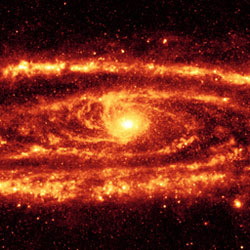
Giant mosaic of Andromeda made up of 11,000 images. Image credit: NASA/JPL. Click to enlarge.
NASA’s Spitzer Space Telescope has captured a stunning infrared view of Messier 31, the famous spiral galaxy also known as Andromeda.
Andromeda is the most-studied galaxy outside our own Milky Way, yet Spitzer’s sensitive infrared eyes have detected captivating new features, including bright, aging stars and a spiral arc in the center of the galaxy. The infrared image also reveals an off-centered ring of star formation and a hole in the galaxy’s spiral disk of arms. These asymmetrical features may have been caused by interactions with the several satellite galaxies that surround Andromeda.
“Occasionally small satellite galaxies run straight through bigger galaxies,” said Dr. Karl Gordon of the Steward Observatory, University of Arizona, Tucson, lead investigator of the new observation. “It appears a little galaxy punched a hole through Andromeda’s disk, much like a pebble breaks the surface of a pond.”
The new false-color Andromeda image is available at http://www.spitzer.caltech.edu/spitzer/ .
Approximately 2.5 million light-years away, Andromeda is the closest spiral galaxy and is the only one visible to the naked eye. Unlike our Milky Way galaxy, which we view from the inside, Andromeda is studied from the outside. Astronomers believe that Andromeda and the Milky Way will eventually merge together.
Spitzer detects dust heated by stars in the galaxy. Its multiband imaging photometer’s 24-micron detector recorded approximately 11,000 separate infrared snapshots over 18 hours to create the new comprehensive mosaic. This instrument’s resolution and sensitivity is a vast improvement over previous infrared technologies, enabling scientists to trace the spiral structures within Andromeda to an unprecedented level of detail.
“In contrast to the smooth appearance of Andromeda at optical wavelengths, the Spitzer image reveals a well-defined nuclear bulge and a system of spiral arms,” said Dr. Susan Stolovy, a co-investigator from the Spitzer Science Center at the California Institute of Technology, Pasadena.
The galaxy’s central bulge glows in the light emitted by warm dust from old, giant stars. Just outside the bulge, a system of inner spiral arms can be seen, and outside this, a well-known prominent ring of star formation.
NASA’s Jet Propulsion Laboratory, Pasadena, Calif., manages the Spitzer mission for NASA’s Science Mission Directorate, Washington. Science operations are conducted at the Spitzer Science Center at the California Institute of Technology. The Jet Propulsion Laboratory is a division of Caltech.
Original Source: NASA/JPL News Release
Ariane Rocket Blasts Off with Two Satellites
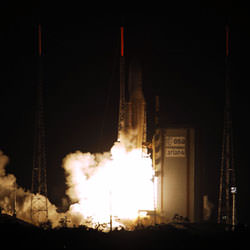
Ariane 5 rocket with two satellites on board. Image credit: ESA. Click to enlarge.
Just after midnight an Ariane 5GS successfully lifted off from Europe?s Spaceport in French Guiana. The two solid boosters ignited 7 seconds after the start-up of the cryogenic main stage, providing the power needed to lift the heavy launcher off the pad.
On board was a Syracuse 3A, built by Alcatel Alenia Space for the French Ministry of Defence and a Galaxy 15 communications satellite built by Orbital Sciences Corporation, USA, for the American company PanAmSat. Galaxy 15 is the 20th satellite to be launched by Ariane launchers for this satellite communications operator.
On arriving at orbital injection, around 26 minutes after launch, the Ariane 5 was at an altitude of about 1560 km and travelling at approximately 8633 metres a second. Syracuse 3A was the first satellite to be released, followed approximately 10 minutes later by the Galaxy 15. Both satellites have been placed in the targeted geostationary transfer orbit with very high precision.
Flight 168 is the 23rd Ariane 5 launch.
Original Source: ESA News Release
Annular Eclipse by Martin Whipp
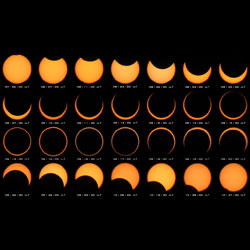
Annular eclipse. Image credit: Martin Whipp. Click to enlarge.
Stars Form Near the Heart of the Milky Way
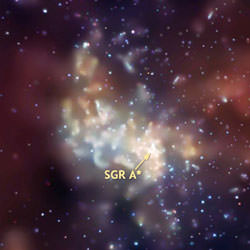
Chandra image of Sgr A*. Image credit: Chandra. Click to enlarge.
NASA’s Chandra X-ray Observatory revealed a new generation of stars spawned by a super-massive black hole at the center of the Milky Way galaxy. This novel mode of star formation may solve several mysteries about these super-massive black holes that reside at the centers of nearly all galaxies.
“Massive black holes are usually known for violence and destruction,” said Sergei Nayakshin of the University of Leicester, United Kingdom. “So it’s remarkable this black hole helped create new stars, not just destroy them.”
Black holes have earned their fearsome reputation because any material, including stars, that falls within their “event horizon” is never seen again. These new results indicate immense disks of gas, orbiting many black holes at a safe distance from the event horizon, can help nurture the formation of new stars. This conclusion comes from new clues that could only be revealed in X-rays. Until the latest Chandra results, researchers have disagreed about the origin of a mysterious group of massive stars discovered by infrared astronomers.
The stars orbit less than a light year from the Milky Way’s central black hole, which is known as Sagittarius A* (Sgr A*). At such close distances to Sgr A*, the standard model for star forming gas clouds predicts they should have been ripped apart by tidal forces from the black hole. Two models, based on previous research, to explain this puzzle have been proposed. In the disk model, the gravity of a dense disk of gas around Sgr A* offsets the tidal forces and allows stars to form.
In the migration model, the stars formed in a cluster far away from the black hole and then migrated in to form the ring of massive stars. The migration scenario predicts about a million low mass, sun-like stars in and around the ring. In the disk model, the number of low mass stars could be much less.
Researchers used Chandra observations to compare the X-ray glow from the region around Sgr A* to the X-ray emission from thousands of young stars in the Orion Nebula star cluster. They found the Sgr A* star cluster contains only about 10,000 low mass stars, thereby ruling out the migration model. Because the galactic center is shrouded in dust and gas, it has not been possible to look for the low-mass stars in optical observations. X-ray data have allowed astronomers to penetrate the veil of gas and dust and look for these low mass stars.
This research, coauthored by Nayakshin and Rashid Sunyaev of the Max Plank Institute for Physics in Garching, Germany, will appear in an upcoming issue of the Monthly Notices of the Royal Astronomical Society.
“In one of the most inhospitable places in our galaxy, stars have prevailed,” Nayakshin said. “It appears star formation is much more tenacious than we previously believed.” “We can say the stars around Sgr A* were not deposited there by some passing star cluster, rather they were born there,” Sunyaev said. “There have been theories that this was possible, but this is the first real evidence. Many scientists are going to be very surprised by these results.”
The research suggests the rules of star formation change when stars form in the disk surrounding a giant black hole. Because this environment is very different from typical star formation regions, there is a change in the proportion of stars that form. For example, there is a much higher percentage of massive stars in the disks around black holes.
NASA’s Marshall Space Flight Center, Huntsville, Ala., manages the Chandra program for the Science Mission Directorate. The Smithsonian Astrophysical Observatory controls science and flight operations from the Chandra X-ray Center in Cambridge, Mass. For more information about this research on the Web, visit:
Additional information and images are available at:
http://chandra.harvard.edu and http://chandra.nasa.gov
Original Source: Chandra News Release
Help Out Gulf Coast Astronomers

Astrophoto: IC405 by Tom Davis
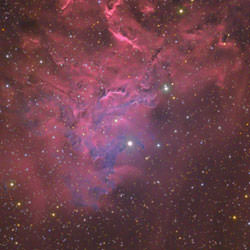
Flaming Star Nebula (IC405). Image credit: Tom Davis. Click to enlarge.
